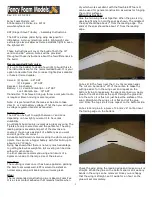
WING
The Learjet 20 has a sweptback, cantilevered,
all-metal wing (Figure 1-15) which is mounted
to the lower fuselage. Most of the wing is
sealed to form an integral fuel tank.
Eight fittings attaching the wings to the fuse-
lage are designed to prevent wing deflections
from inducing secondary loads in the pressur-
ized fuselage. Ailerons are attached to the rear
spar at three hinge points. The single-slotted
flaps are attached to the inboard rear spar by
tracks, rollers, and hinges. The spoilers are at-
tached to the top of the wing surface by two
hinges just forward of the flaps. The tip tanks
are secured to the wing by two attach points.
The Learjet 20 wing is fitted with either vor-
tex generators or boundary layer energizers.
Whichever is used, their function is to delay
airflow separation over the ailerons at high
Mach numbers.
Model 23 airplanes have two rows of vortex
generators bonded to the upper and lower wing
surface forward of the ailerons. Each of the
four rows has 26 vortex generators. A maxi-
mum of three vortex generators on each wing
are allowed to be missing before flight.
All 24 and 25 models (except those with
boundary layer energizers) have two rows of
vortex generators bonded to the upper wing
surface only. The forward row has 26 vortex
generators installed; the rear row has 19. A
maximum of three vortex generators on each
wing are allowed to be missing before flight.
O n a i r p l a n e s i n c o r p o r a t i n g A M K 8 3 - 4 ,
Softflite I, and AMK 83-5 Softflite wing mod-
ifications, the vortex generators have been re-
placed with the following:
• Two rows of boundary layer energizers
(BLEs) on each wing which perform the
same function as vortex generators but
are more efficient. If any are missing,
M
MO
is reduced to 0.78 M
I
.
• A full-chord fence on each wing, in-
board of the aileron, which reduces span-
wise flow of air.
• A stall strip, affixed to the inboard sec-
tion of each wing leading edge, which
generates a buffet at high angle of attack
to warn of an impending stall and ensures
that the inboard wing stalls first
• Aileron gap seals
On airplanes equipped with the Dee Howard
MKII wing, the vortex generators have been
removed. Wing-to-tip fuel tanks strakes have
been enlarged and air gap seals have been in-
stalled forward of the ailerons. Stall strips
have been added to the leading edges of the
w i n g s . A i r p l a n e s e q u i p p e d w i t h t h e D e e
Howard XR wing have elongated and curved
strakes, stall strips, boundary layer energiz-
ers, two span flow limiters per wing, and a
thickened wing root area formed by two glove
tanks containing 40 gallons of fuel per side.
EMPENNAGE
The T-tail empennage (Figure 1-16) includes
a vertical stabilizer with an attached rudder and
a variable incidence horizontal stabilizer with
attached elevators. An electrically operated
actuator pivots the stabilizer about the rear
spar attach point for longitudinal trim.
1-15
FOR TRAINING PURPOSES ONLY
Figure 1-16. Empennage
LEARJET 20 SERIES PILOT TRAINING MANUAL
FlightSafety
international
















































